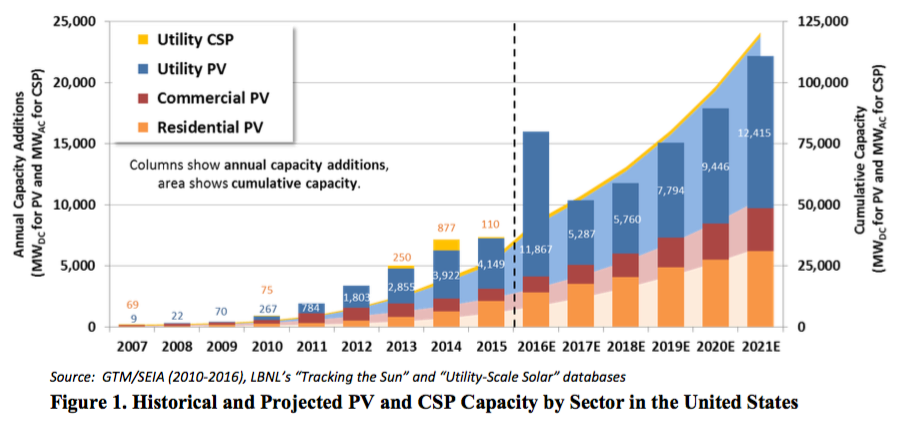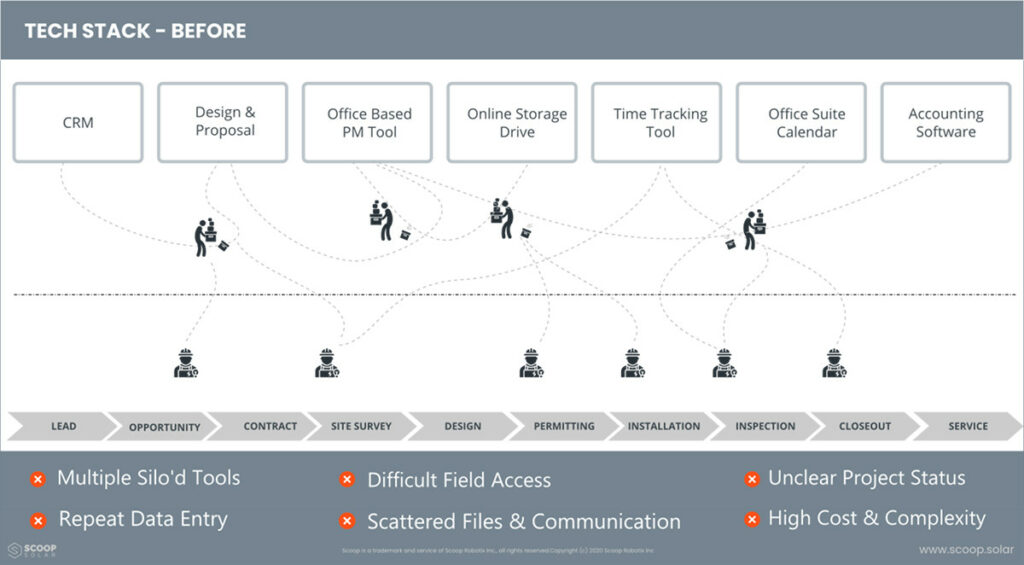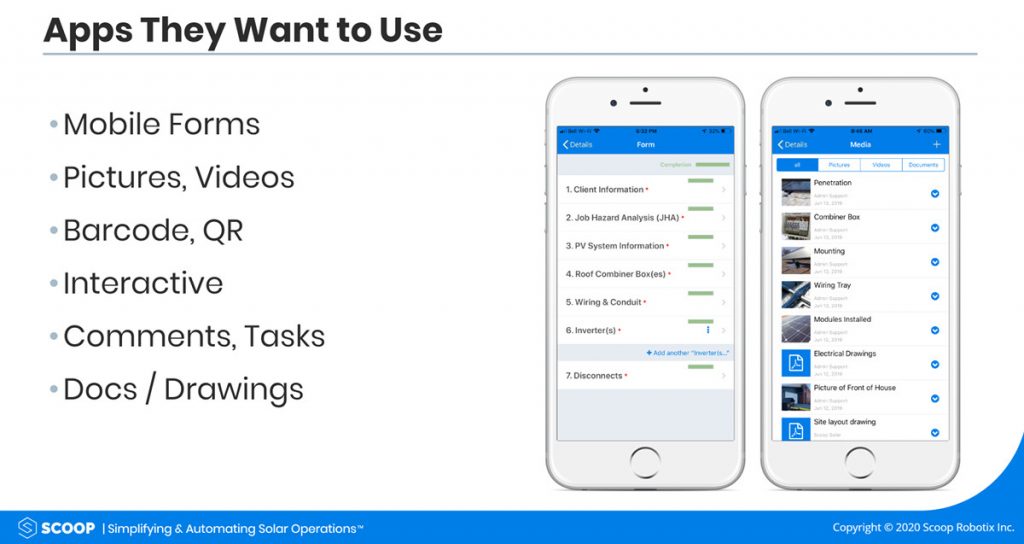Death by a Th0usand Inefficiencies
“My goal is to ensure every one of my employees & contractors on every project team have what they need to do their job efficiently and effectively…”
-VP of Operations, Scoop Customer (50 residential installs/month)
Growing Pains
“Don’t wait until you have a capacity or bandwidth crisis to engineer a transformation…”
Despite the excitement of growth many of our customers experience, we know there can be significant challenges and pains associated with the expansion from 5-10 projects/month to 20, 50 and beyond. The tools that supported your office and field teams when you started are less and less effective as you grow – taking more time and effort to manage and keep afloat than the value they provide value.

One of the key challenges introduced during periods of growth is the insidious and gradual drop in the productivity of existing systems & methods for executing operations. Akin to the tale of the frog being slowly brought up to boil, teams don’t immediately sense the accumulation of inefficiencies stemming from tens, then hundreds and soon thousands of small and seemingly insignificant transactions throughout their operations. As a result, despite the significant total negative impact, they become habituated to inefficiencies and learn to live with, work around or find quick fix alternatives such as documents, spreadsheets and consumer tools to fill in the gaps, resulting in more inefficiency and complexity.
Inefficiency: the Invisible Enemy
“The operational inefficiencies caused by growth are insidious – they occur slowly, flying under the radar taking the form of hundreds, if not thousands of seemingly insignificant transactions.”
The distributed and insidious nature of these inefficiencies makes it especially hard for operational leaders to point a clear finger at the problem or to easily quantify the total operational cost. It can therefore be even harder for frontline managers to get owners and executives on board and interested in investing in transformative solutions – since after all, there is never a shortage of fires to fight and immediate priorities or opportunities to tend to.
The reality is however that as the business takes on more such opportunities, projects, new clients or lines of business, the “process-debt” not only doesn’t go away, but grows exponentially upon itself until a breaking point or crisis is reached. Such crises typically manifest as a rapid and sometimes catastrophic drop in customer satisfaction, brand reputation, employee morale and capacity for growth. It is only at this point -when the impact of the process debt suddenly becomes apparent -that leadership frantically casts about in search of a solution.

Some Things Get Worse with Waiting
In fact and sadly, a number of companies seeking out our solutions and services here at Scoop approach us at or near the crisis stage. Surely, it is never too late to implement digital transformation, but it is clearly a lot more efficient and less challenging when a solution is implemented proactively, affording everyone the time and space to deliberate on the best solution options and for the teams and the company to, in effect ‘grow up’ with a culture of transparency, process-minded-ness and accountability. We often hear from leaders and managers who postpone digital transformation. They peg this to when ‘the busy season ends’ or ‘when the next set of contracts come in’ or ‘when the accounting software is ready’. In our experience with hundreds of solar and renewable energy firms, while valid reasons for waiting do exist, they are few and far in between. In fact things often only get more complex and expensive to change as time goes on, bad habits get learned and entrenched and operations become more complex.
Common Operational Efficiency Themes in Solar
The nature of our work affords us the opportunity to see the above-mentioned scenarios and patterns play out across hundreds of solar, battery storage and other sustainable energy businesses we work with in North America. This series is an attempt to share the common trends in operational efficiency pitfalls we see among growing solar businesses. We will also share where we have observed Scoop customers realizing up to 15x Return on Investment based on having the right scalable system in place –while it may seem incredible, 15x ROI is no made up number – we have run rigorous case studies with our customers to “bean count” the cost of every inefficiency across the operation.
As you review your systems and consider what is required for the next tidal wave of growth, we wanted to share the top 5 capabilities your Project Management and Operations System must have.
Part 1: The Right Tool for Your Field Team
Email. Text. WhatsApp. Dropbox. Slack. Google Suite. Excel. Microsoft Office. CRMs. GCal. Outlook. Docusign. Quickbooks. A small smorgasbord of the tools we observe solar operators asking their internal field teams and contractors to use – often 2, 3 or 4 at a time while on-site.
Where Value is Created
What is the cost associated when every member of your growing team is required to seek out and regain context from information fragmented across disparate systems and folders for each project they work on?
If you’re an Residential, Commercial or Utility solar installer / EPC or responsible for service and O&M, you know how critical your team’s role is in ensuring projects and services are executed on time, on budget and with quality. Sure, your install crew or site surveyor can manage going to a couple of job sites every week, pulling up their Google calendar, logging into a clunky web-based CRM on their phone, finding the right dropbox folder to review images or documents – but what about when that Site Surveyor is now responsible for a team visiting multiple sites per day?
The costs associated with switching between multiple apps and systems exponentially increases as the volume of business, the number of clients or projects increases. What compounds this issue is the cost to every single member of your team required to seek out and regain fragmented context for each project, usually requiring data from several sources.
Minutes and hours here and there that add up to $1,000’s and $10,000’s of profit lost on a monthly basis – and more importantly consume bandwidth that could be available to grow and take on more opportunities and projects.
The Right Solar Project Management Tool for the Job
Your Sales Reps, Site Surveyors, Engineers and Installers should all have one place they go to execute their entire phase of the project. It should be built for their information needs and setting – remote and mobile or home and office. They should not have to worry about where to save pictures and whom to call to make sure that the person responsible for naming and uploading it back at the office has the right context. If it’s easier for them to record a video of an issue and assign it as a task to someone else – they need to be able to do that in one click – so they can quickly move on and get the job done without the risk of that falling through the cracks.
It’s not your field team’s job to understand how to use complex technology platforms – they want to do a great job on site and you want them to get on, have easy access to what they need to execute, and move onto the next site as quickly as possible. We are often told folks in the field don’t want to use their phones – that using an App is too complicated and frustrating. Time and time again we see and hear Scoop field teams actually improving the quality of work experience on site because it makes the onsite and office team’s life exponentially easier and less complex.
Time and time again we see an App like Scoop actually improving the field teams quality of work experience on-site or at the office because it makes the workflow exponentially easier and more efficient.
Give them the right tool to do their job and you’ll find yourself executing more monthly projects with the same size team – sometimes by a factor of 3-4x.
“Must Have’s” for Your Field Work Execution Tool
Here are the features and capabilities your team on the ground should have access to in one place:
- Calendar – A native calendar directly integrated with their work items (one click to access & execute work)
- Data Capture – A single form to capture data, documents, photos, videos, signatures, scan codes and record voice comments.
- Real time Issues & Snags – The ability to log & escalate issues, assign other team members to tasks, markup pictures and record voice overs.
- Field & Office Communication – Collaboration at the form field level, so that anyone at the office can see what comments/issues are related to (the electrical panel image (form field 3.2.1) at Kathy Jones’ residence).
- On-site Review – Ability to submit their on-site work process for review triggering a real-time notification for the right PM to review and sign off before crew leaves site.
- Offline Availability: ability to work without an Internet connection and without the app getting laggy or lose data.
- A Single Tool – Eliminating the need for the crew to have to upload/email/text pictures or other documentation for the purposes of report generation or customer communication. This can and should be automated.
At Scoop we live and breath solar operations. We love digging into the weeds of our customers process, helping to identify areas of significant inefficiency and then implementing automated and standardized processes that eliminate time and energy wanted here.

It Doesn’t Have to be Complicated
The fact is, solar teams are busy. They have a lot going on and the traditional IT deployment approach (as seen with many CRM rollouts) stretching over months and having managers do reams of ‘homework’ is just not practical. We designed a technology platform that delivers simplicity at every step of the way from setup to deployment with our drag-and-drop app builder, easy to navigate wizards and common. Because the platform streamlines and automates work one process (or one App) at a time, it is feasible to start small with a handful of key processes like sales visits, site surveys, installation checklists and closeouts and gradually work our way with clients to more automation.
From our first Discovery & Demo meeting with you we roll up our sleeves and play the role of ‘trusted advisor’, seeking to understand your business and where the greatest operational system improvements lie.


